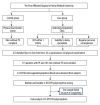Biallelic and Triallelic 5-Hydroxytyramine Transporter Gene-Linked Polymorphic Region (5- HTTLPR) Polymorphisms and Their Relationship with Lifelong Premature Ejaculation: A Case-Control Study in a Chinese Population
- PMID: 27311544
- PMCID: PMC4920104
- DOI: 10.12659/msm.896768
Biallelic and Triallelic 5-Hydroxytyramine Transporter Gene-Linked Polymorphic Region (5- HTTLPR) Polymorphisms and Their Relationship with Lifelong Premature Ejaculation: A Case-Control Study in a Chinese Population
Abstract
BACKGROUND This study aimed to explore the relationship between premature ejaculation (PE) and the serotonin transporter gene-linked polymorphic region (5-HTTLPR) with respect to the biallelic and triallelic classifications. MATERIAL AND METHODS A total of 115 outpatients who complained of ejaculating prematurely and who were diagnosed as having lifelong premature ejaculation (LPE) and 101 controls without PE complaint were recruited. All subjects completed a detailed questionnaire and were genotyped for 5-HTTLPR polymorphism using PCR-based technology. We evaluated the associations between 5-HTTLPR allelic and genotypic frequencies and their association with LPE, as well as the intravaginal ejaculation latency time (IELT) of different 5-HTTLPR genotypes among LPE patients. RESULTS The patients and controls did not differ significantly in terms of any characteristic except age. The results showed no significant difference regarding biallelic 5-HTTLPR. According to the triallelic classification, no significant difference was found when comparing the genotypic distribution (P=0.091). However, the distribution of the S, LG, and LA alleles in the cases was significantly different from the controls (P=0.018). We found a significantly lower frequency of LA allele and higher frequency of LG allele in patients. Based on another classification by expression, we found a significantly lower frequency of the L'L' genotype (OR=0.37; 95%CI=0.15-0.91, P=0.025) in patients with LPE. No significant association was detected between IELT of LPE and different genotypes. CONCLUSIONS Contrary to the general classification based on S/L alleles, triallelic 5-HTTLPR was associated with LPE. Triallelic 5-HTTLPR may be a promising field for genetic research in PE to avoid false-negative results in future studies.
Figures
Similar articles
-
Association of STin2 VNTR Polymorphism of Serotonin Transporter Gene with Lifelong Premature Ejaculation: A Case-Control Study in Han Chinese Subjects.Med Sci Monit. 2016 Oct 7;22:3588-3594. doi: 10.12659/msm.897720. Med Sci Monit. 2016. PMID: 27713390 Free PMC article.
-
Serotonin transporter promoter region (5-HTTLPR) polymorphism is associated with the intravaginal ejaculation latency time in Dutch men with lifelong premature ejaculation.J Sex Med. 2009 Jan;6(1):276-84. doi: 10.1111/j.1743-6109.2008.01033.x. J Sex Med. 2009. PMID: 19170855
-
A meta-analysis of the effects of the 5-hydroxytryptamine transporter gene-linked promoter region polymorphism on susceptibility to lifelong premature ejaculation.PLoS One. 2013;8(1):e54994. doi: 10.1371/journal.pone.0054994. Epub 2013 Jan 30. PLoS One. 2013. PMID: 23383022 Free PMC article.
-
[Correlation of 5-hydroxytryptamine transporter gene-linked polymorphic region with lifelong premature ejaculation: Progress in studies].Zhonghua Nan Ke Xue. 2018 Mar;24(3):268-271. Zhonghua Nan Ke Xue. 2018. PMID: 30161315 Review. Chinese.
-
[Correlation of lifelong premature ejaculation with 5-HT system gene polymorphism].Zhonghua Nan Ke Xue. 2021 Aug;27(8):748-752. Zhonghua Nan Ke Xue. 2021. PMID: 34914250 Review. Chinese.
Cited by
-
Association between the serotonin transporter linked polymorphic region and lifelong premature ejaculation: An updated meta-analysis of case-control studies.Medicine (Baltimore). 2020 Oct 9;99(41):e22169. doi: 10.1097/MD.0000000000022169. Medicine (Baltimore). 2020. PMID: 33031260 Free PMC article.
-
Association between 5-hydroxytryptamine transporter gene-linked promoter region polymorphism and the susceptibility of lifelong premature ejaculation: a meta-analysis involving 1,604 subjects.Transl Androl Urol. 2020 Jun;9(3):1394-1404. doi: 10.21037/tau.2020.03.39. Transl Androl Urol. 2020. PMID: 32676424 Free PMC article. Review.
-
Guibourtia tessmannii-induced fictive ejaculation in spinal male rat: involvement of D1, D2-like receptors.Pharm Biol. 2017 Dec;55(1):1138-1143. doi: 10.1080/13880209.2017.1291692. Pharm Biol. 2017. PMID: 28218041 Free PMC article.
References
-
- Montorsi F. Prevalence of premature ejaculation: A global and regional perspective. J Sex Med. 2005:296–102. - PubMed
-
- Hatzimouratidis K, Amar E, Eardley I, et al. Guidelines on male sexual dysfunction: erectile dysfunction and premature ejaculation. Eur Urol. 2010;57(5):804–14. - PubMed
-
- Godpodinoff ML. Premature ejaculation: clinical subgroups and etiology. J Sex Marital Ther. 1989;15(2):130–34. - PubMed
-
- McMahon CG, Althof SE, Waldinger MD, et al. An evidence-based definition of lifelong premature ejaculation: report of the International Society for Sexual Medicine (ISSM) ad hoc committee for the definition of premature ejaculation. J Sex Med. 2008;5(7):1590–606. - PubMed
-
- Gao J, Zhang X, Su P, et al. Prevalence and factors associated with the complaint of premature ejaculation and the four premature ejaculation syndromes: a large observational study in China. J Sex Med. 2013;10(7):1874–81. - PubMed
MeSH terms
Substances
LinkOut - more resources
Full Text Sources



